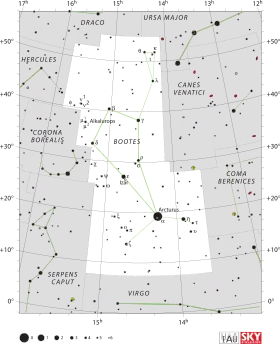Sigma Bootis
Sigma Bootis (σ Boo, σ Bootis) est une étoile de la constellation du Bouvier.
| Ascension droite | 14h 34m 40,81699s[1] |
|---|---|
| Déclinaison | +29° 44′ 42,4590″[1] |
| Constellation | Bouvier |
| Magnitude apparente | 4,46[2] |
Localisation dans la constellation : Bouvier  | |
| Type spectral | F4VkF2mF1[3] |
|---|---|
| Indice U-B | −0,084[2] |
| Indice B-V | +0,366[2] |
| Indice R-I | 0,19 |
| Variabilité | Suspectée[4] |
| Vitesse radiale | +0,37 ± 0,09 km/s[5] |
|---|---|
| Mouvement propre |
μα = +188,35 mas/a[1] μδ = +131,77 mas/a[1] |
| Parallaxe | 63,16 ± 0,25 mas[1] |
| Distance |
51,6 ± 0,2 al (15,83 ± 0,06 pc) |
| Magnitude absolue | 3,52[6] |
| Masse | 1,48 M☉[7] |
|---|---|
| Rayon | 1,431 ± 0,023 R☉[8] |
| Gravité de surface (log g) | 4,30[6] |
| Luminosité | 3,461 ± 0,042 L☉[8] |
| Température | 6 594 ± 55 K[8] |
| Métallicité | −0,24[9] |
| Rotation | 7,32 km/s[10] |
| Âge | 1,7 G a[11] |
Autres désignations
σ Boo, 28 Bootis (Flamsteed), BD+30°2536, GJ 557, HD 128167, HIP 71284, HR 5447, SAO 83416, GC 19659, CCDM 14347 +2945[12]
Sigma Bootis est une étoile jaune-blanc de la séquence principale de type spectral F4V[3] avec une magnitude apparente de +4,46[2]. Elle est située à environ ∼51,6 a.l. (∼15,8 pc) de la Terre[1].
Située au sud-est de Rho Bootis, Sigma apparaît au premier abord comme une étoile double visuelle, mais la proximité angulaire avec Rho est un simple effet de ligne de visée. Comme beaucoup d'étoiles de son type spectral, Sigma est apparemment une variable de type Delta Scuti, qui varie légèrement sur une période de quelques heures[réf. souhaitée].
Les relevés effectués dans l'infrarouge avec les télescopes spatiaux Spitzer et Herschel n'ont pas permis de détecter un excès d'infrarouge en provenance de l'étoile à une longueur d'onde de 160 μm, qui serait indicatif de la présence d'un disque circumstellaire. Cependant, le relevé HOSTS effectué avec le grand télescope binoculaire a permis la détection d'un excès dans l'infrarouge lointain, indiquant la présence de poussière exozodiacale autour de la zone habitable de l'étoile[13].
En chinois, 梗河 (Gěng Hé), signifiant Bouclier, fait référence à un astérisme constitué de σ Bootis, ε Bootis et ρ Bootis[14]. Par conséquent, σ Bootis elle-même est appelée 梗河二 (Gěng Hé èr, la deuxième étoile du Bouclier)[15].
Références
- (en) F. van Leeuwen, « Validation of the new Hipparcos reduction », Astronomy & Astrophysics, vol. 474, no 2, , p. 653–664 (DOI 10.1051/0004-6361:20078357, Bibcode 2007A&A...474..653V, arXiv 0708.1752)
- (en) J. E. Elliott, « Study of delta Scuti variables », Astronomical Journal, vol. 79, , p. 1082–1090 (DOI 10.1086/111657, Bibcode 1974AJ.....79.1082E)
- (en) R. O. Gray, M. G. Napier et L. I. Winkler, « The Physical Basis of Luminosity Classification in the Late A-, F-, and Early G-Type Stars. I. Precise Spectral Types for 372 Stars », The Astronomical Journal, vol. 121, no 4, , p. 2148–2158 (DOI 10.1086/319956, Bibcode 2001AJ....121.2148G)
- Samus, O. V. Durlevich et al., « VizieR Online Data Catalog: General Catalogue of Variable Stars (Samus+ 2007-2013) », VizieR On-line Data Catalog: B/gcvs. Originally published in: 2009yCat....102025S, vol. 1, (Bibcode 2009yCat....102025S)
- (en) David L. Nidever et al., « Radial Velocities for 889 Late-Type Stars », The Astrophysical Journal Supplement Series, vol. 141, no 2, , p. 503–522 (DOI 10.1086/340570, Bibcode 2002ApJS..141..503N, arXiv astro-ph/0112477)
- E. Paunzen et al., « Investigating the possible connection between λ Bootis stars and intermediate Population II type stars », Astronomy & Astrophysics, vol. 567, , p. 8 (DOI 10.1051/0004-6361/201423817, Bibcode 2014A&A...567A..67P, arXiv 1406.3936)
- (en) Trevor J. David et Lynne A. Hillenbrand, « The Ages of Early-Type Stars: Strömgren Photometric Methods Calibrated, Validated, Tested, and Applied to Hosts and Prospective Hosts of Directly Imaged Exoplanets », The Astrophysical Journal, vol. 804, no 2, , p. 146 (DOI 10.1088/0004-637X/804/2/146, Bibcode 2015ApJ...804..146D, arXiv 1501.03154)
- Boyajian et al., « Stellar Diameters and Temperatures. I. Main-sequence A, F, and G Stars », The Astrophysical Journal, vol. 746, no 1, , p. 101 (DOI 10.1088/0004-637X/746/1/101, Bibcode 2012ApJ...746..101B, arXiv 1112.3316). Voir Table 10.
- T. Bensby, S. Feltzing et M. S. Oey, « Exploring the Milky Way stellar disk. A detailed elemental abundance study of 714 F and G dwarf stars in the solar neighbourhood », Astronomy & Astrophysics, vol. 562, no A71, , p. 28 (DOI 10.1051/0004-6361/201322631, Bibcode 2014A&A...562A..71B, arXiv 1309.2631)
- (en) R. Martínez-Arnáiz et al., « Chromospheric activity and rotation of FGK stars in the solar vicinity. An estimation of the radial velocity jitter », Astronomy & Astrophysics, vol. 520, , A79 (DOI 10.1051/0004-6361/200913725, Bibcode 2010A&A...520A..79M, arXiv 1002.4391)
- G. Decin et al., « Age Dependence of the Vega Phenomenon: Observations », The Astrophysical Journal, vol. 598, no 1, , p. 636–644 (DOI 10.1086/378800, Bibcode 2003ApJ...598..636D, arXiv astro-ph/0308294)
- (en) * sig Boo -- High proper-motion Star sur la base de données Simbad du Centre de données astronomiques de Strasbourg.
- (en) S. Ertel et al., « The HOSTS Survey—Exozodiacal Dust Measurements for 30 Stars », The Astronomical Journal, vol. 155, no 5, , p. 19 (DOI 10.3847/1538-3881/aab717, Bibcode 2018AJ....155..194E, arXiv 1803.11265)
- (zh) 中國星座神話, written by 陳久金. Published by 台灣書房出版有限公司, 2005, (ISBN 978-986-7332-25-7).
- (zh) AEEA (Activities of Exhibition and Education in Astronomy) 天文教育資訊網 2006 年 6 月 29 日
Liens externes
- (en) Sigma Bootis sur la base de données Simbad du Centre de données astronomiques de Strasbourg.
- HR 5447
- CCDM J14347+2945
- Image Sigma Boötis
- Portail de l’astronomie
- Portail des étoiles